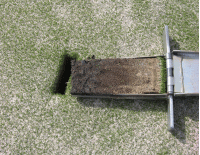 A significant amount of time and resources is spent on managing the sand particles that remain on the putting surface after topdressing is incorporated. A significant amount of time and resources is spent on managing the sand particles that remain on the putting surface after topdressing is incorporated. |
Superintendents welcome techniques that improve the efficiency of operations on the golf course. The incorporation of topdressing sand into a turfgrass canopy is one of those practices where a gain in efficiency is beneficial. Significant time and other resources can be spent on managing the sand particles left on the putting surface after most of the topdressing is incorporated. These remnant particles are typically large (fine gravel, very coarse, or coarse particles, depending on the quality of the sand) and interfere with mowing and potentially play, if not removed. Blowers can be used to remove these particles, but at the cost of more labor and fuel. Daily mowing eventually removes these large particles, but at the cost of increased mower maintenance through more frequent sharpening and replacement of bedknives and reels.
The incorporation of topdressing sand is more difficult on turf maintained at lower mowing heights and with plant growth regulation that increases shoot density, calculated as the number of turfgrass shoots per square inch. Additionally, newer cultivars developed for putting greens have much greater shoot density compared to older cultivars. Topdressing sand increases the firmness of a putting green surface due to the “bridging” of sand particles within the turf canopy and layer of mat or thatch. However, the bridging among sand particles and with plant material also contributes to the difficulty of incorporating sand.
Techniques to improve the incorporation of topdressing sand include:
- Using dry sand.
- Drying the putting surface before applying the topdressing.
- Verticutting or grooming the putting surface before applying the topdressing.
- Applying the topdressing more frequently at lower application rates.
- Using a sand with fewer large particles.
|
Summary Points • Sand topdressing, regardless of sand size, has yet to provide consistent effects on surface firmness or volumetric water content in either trial. More differences may emerge as cumulative amounts of sand topdressing increase throughout subsequent years of these trials. A drum roller equipped with golf shoe spikes is being designed and constructed to simulate foot traffic on these plots in 2012. Surface firmness across treatments may become more apparent once traffic is implemented. • On velvet bentgrass turf, topdressing sand applied every two weeks, particularly at 100 pounds per 1,000 square feet, provided better turf quality compared to the non-topdressed plots. With repeated treatment, plots topdressed with medium fine sand eventually had better turf quality than plots topdressed with medium-coarse sand. • Regardless of sand size, topdressing annual bluegrass every two weeks improved turf quality compared to the non-topdressed plots. In addition, anthracnose disease symptoms were less severe in all topdressed plots by late summer. • To date, we have not observed any negative effects of topdressing with finer sand on either velvet bentgrass or annual bluegrass maintained as putting green turf. Please note that the finer sands being used in these trials were dominated by medium sand with less than three percent very fine sand content and essentially no silt or clay content. We will continue these topdressing treatments and observations during 2012. |
Movement of sand particles into the turf canopy and mat of a putting surface is inhibited by moisture, regardless of whether the water is within the sand or turf itself. Water acts like glue causing the sand particles to stick to each other (bridge) and to the leaves (and other parts) of the grass plants as well. This bridging effect impedes the movement of sand deep into the turf. Practices such as grooming and verticutting are done to open the turf canopy and reduce the amount of bridging, allowing more of the sand particles to fall deeper into the turf canopy and thatch. Topdressing at lower rates also serves to reduce the bridging of sand particles because particles are not as close together, thus improving incorporation. It is essential, however, that lower rates of topdressing be applied more frequently to achieve the same total rate of topdressing, otherwise the objective for topdressing will not be realized.
Many have adopted the strategy of selecting sand that contains no fine gravel (2 to 3.4 mm particle size diameter) or very coarse sand (1 to 2 mm) to improve incorporation of topdressing. More recently, some are selecting sands that do not contain coarse sand (0.5 to 1 mm), which further improves the ability to incorporate the topdressing, especially when it is dry. While these “cleaner” sands greatly improve incorporation, there is concern that sand less than 0.5 mm in size has the potential to negatively change the physical properties of the developing mat (thatch) layer of a putting green.
Potential issues. Eliminating the larger particles results in more of the particles being similar in size, and this is referred to as poorly or uniformly graded. Uniformly graded sands are more susceptible to instability problems, meaning that the sand particles may shift under traffic. Additionally, finer sand can retain more water and slow its movement. The extent to which these concerns are actually a problem in the context of topdressing is not fully understood. For example, some finer sands, despite being uniformly graded, can pack together and be more stable than coarser sand. Moreover, what we know about the behavior of sands is typically drawn from studies of sand-based rootzones rather than topdressing sand applied to an accumulating mat (thatch) layer.
In an attempt to offset any potential negative impacts of finer topdressing sand, some superintendents are using two sand sizes. This approach uses a coarser sand for the backfill after core aeration, and a finer sand is used for surface topdressing applications. Thus, the concept is to manage any potentially negative effects by coring out the mat layer containing finer sand and replacing it with coarse sand backfill. It is not clear whether this “dual sand” concept will be sufficient to offset any negative effects of the finer sand, presuming that negative effects actually occur.
Research at Rutgers. Two research trials were recently initiated at Rutgers University to evaluate the effects of topdressing sand varying in particle size distribution on turfgrass quality and surface firmness. Our trials compare the use of coarse medium and medium-fine sands on turfs with different thatching tendencies.
Our first field trial was initiated in 2010 on Greenwich velvet bentgrass putting green turf, which has a great thatching tendency. The plots were mowed daily at 0.11 inch with a triplex mower. Irrigation was applied to these plots but only enough to relieve the initial signs of wilt stress, which serves as the indicator to apply water. Either coarse-medium or medium-fine sand was applied every two weeks at 50 or 100 pounds per 1,000 square feet. The plots were evaluated for turf quality, turf color, sand presence, digital image analysis, post-topdressing clipping collection, volumetric water content (0- to 1.5-inch depth), and surface hardness (Clegg Impact Soil Tester [2.25 and 0.5 kg] and USGA TruFirm).
 Research has shown that frequent applications of topdressing help to manage disease issues. Research has shown that frequent applications of topdressing help to manage disease issues. |
Substantial differences in firmness or quality were not apparent during 2010; however, all topdressing treatments displayed better turfgrass quality than the non-topdressed check plots by early June 2011. By the end of June 2011, a topdressing rate effect was observed. Plots topdressed at 100 pounds per 1,000 square feet had better turfgrass quality than plots topdressed at 50 pounds per 1,000 square feet. Additionally, the medium fine sand started to produce better turf quality than the coarse-medium sand during 2011. It was also becoming more evident as the study continued that topdressing sand needed to be applied at the rate of 100 pounds per 1,000 square feet to observe differences between these two sand sizes.
The amount of sand left on the turf surface after topdressing events was different among the sands. As expected, it took more time for the turf surface to become clear of sand when topdressing was done with the coarse medium sand topdressing or at the rate of 100 pounds per 1,000 square feet. Additionally, the amount of sand harvested during mowing was affected the sand was reduced, less sand was removed by mowing. The critical issue that must be evaluated is, will the use of a finer topdressing sand applied over coarser-textured soils have any long-term ramifications? Will infiltration be affected negatively, and/or will free drainage within the profile be unaffected? These issues will be evaluated as research continues.
 Many superintendents have adopted programs using one sand to fill aeration holes and a finer sand to topdress the surfaces. Many superintendents have adopted programs using one sand to fill aeration holes and a finer sand to topdress the surfaces. |
A second field trial was initiated in late June 2011 on annual bluegrass putting green turf. Three sand sizes are being used in this trial: a medium coarse sand, a medium sand (the medium-coarse sand sieved to remove coarse sand with a #35 sieve, 500-μm screen), and a medium-fine sand. Topdressing was applied at 50 pounds per 1,000 square feet every 14 days during the summer months. Data collection in this trial was similar to the velvet bentgrass trial. Additionally, anthracnose severity was evaluated every seven to 10 days.
All topdressing treatments had as good or better turfgrass quality than the non-topdressed plots. As expected, more anthracnose disease was observed on the non-topdressed plots compared to all of the plots receiving topdressing sand. No differences among sand sizes were observed in the first year of this trial.
James A. Murphy, Ph.D. (murphy@aesop.rutgers.edu) is an extension turf specialist in the Department of Plant Biology and Pathology at Rutgers University, New Brunswick, N.J.
This article is reprinted from the September, 2012, vol. 50 (no.19) issue of the USGA Green Section Record. Copyright United States Golf Association. All rights reserved.

Explore the October 2012 Issue
Check out more from this issue and find your next story to read.
Latest from Golf Course Industry
- From the publisher’s pen: Conscientious of a bigger role
- Bernhard and Company partners with Laguna Golf Phuket
- Terre Blanche showcases environmental stewardship
- VIDEO: Introducing our December issue
- Bernhard and Company introduces Soil Scout
- Nu-Pipe donates to GCSAA Foundation’s Centennial Campaign
- GCSAA enhances golf course BMP tool
- Melrose leadership programs sending 18 to 2026 GCSAA Conference and Trade Show





